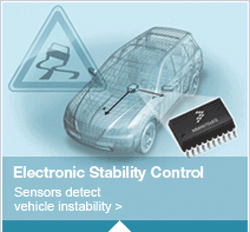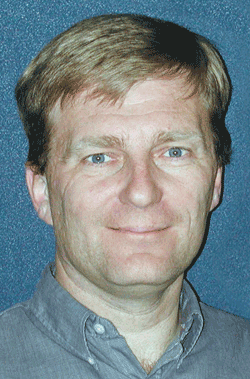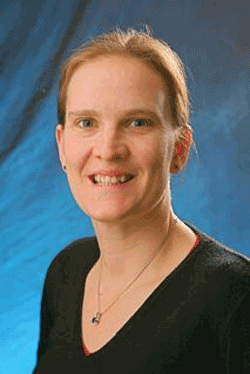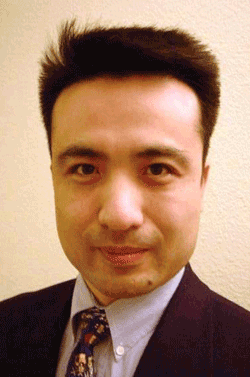Industry experts look into the future of automotive safety
CONVENED AND MODERATED BY CHRISTINA NICKOLAS
Automotive safety represents a growing market for semiconductors and components manufacturers due to influence from governments, consumers, and the automotive makers themselves. We recently gathered a group of industry professionals to discuss trends in electronics safety and more.


Safety trends
Electronic Products : What trends do you see in your area, and how will the current state of the automotive market affect the production of new devices?
Ron Demcko (Applications Engineering Manager, AVX ): In regards to the current state of the automotive manufacturers, we’re actually seeing that they’re trying to design their way out of the existing situation so we find that very impressive. I hope that they continue with their progress in that line. We’re also seeing that suppliers to the automotive market that are diversified can invest in new technologies to help address the ultimate design needs of the car company designers.

But regarding safety, we’re finding that there are three basic areas that need to be addressed: there’s a known implementation of existing solutions, a still-being-developed area, and an unknown system area
From a known point of view, you know, these are things as simple as an increased number of air bags, vision systems or back up cameras, ABS, stability packages etc. So in that respect these known solutions have a predictable demand for more networking, more sensors, higher reliability of existing components that we have.
From a still-being-developed/determined and optimized sector, that might be driven by increased gas mileage vehicles, diesels etc. Basically this sector is an optimization of gas mileage of existing combustion systems. Typically that’s drive by wire, perhaps electric power assist steering etc.
From a component point of view or at least a passive component point of view they’re looking for electrically larger passives with higher voltage capability, higher power capability, and generally the same type of reliability as existing designs.
The unknown, that’s perhaps the biggest player in this whole scenario and holds huge potential. That might be driven by plug-in hybrids trends, hybrid derivatives trends, maybe even battery-powered or fuel-cell vehicle trends, things like that. In this general area we’re seeing very large power devices being needed — fail-safe devices, things that could work at extreme temperatures in fail-safe mode over long periods of time.
So safety is a huge opportunity for us — I ‘d expect all suppliers are concentrating on it, and I would be interested to hear if the other groups are seeing the opportunity to break into those three sectors.
Bob Mosso (Engineering Manager for the automotive business unit, BI Technologies ): BI Technologies sells many types of steering sensors, including both torque and position sensing. To address the questions about the current state of the automotive business market, everyone is aware that automotive orders are down. I think everyone has had orders cut or orders put on hold.

I think BI has been less affected in general because our sensors and our market that we sell into are for electric power steering and those cars tend to be smaller and sold more in the Asian and European markets. So we’re being affected less than general manufacturers supplying to the automotive industry. And I suspect the business will return this year, and things are looking good especially if you’re selling into the smaller cars.
The trends in regards to safety, the two types of sensors that we sell to the automotive market are torque sensors for the steering in the electric power-steering units, which are really not for safety, but more for the trend of better gas mileage; and steering position sensors specifically for safety and the stability control or active handling, which provides information about the steering position to feed that into their computer to decide how to assist the drive.
Trends for active handling or stability control: these are going on more and more vehicles, we’re seeing more and more customers wanting the position sensing on the steering. This trend is going to continue and will be very strong to where nearly all cars especially in North America will be having the stability control as a standard feature.
Guillemette Paour (Global Market Manager for Automotive, Tyco Electronics ): I’m in charge actually of the marketing for our circuit protection products, which basically are overcurrent, overvoltage, and overtemperature devices that in most cases get placed on PCBs in car electronics.

In terms of trends related to safety, I’m not going to comment on the situation. I think everybody’s aware of the automotive situation but on the safety trends I think like everybody else we’re seeing more and more things popping up.
And as the first speaker mentioned some of them being existing and being improved such as park assist, TMPS, and things like that, and some being more towards the future with the line departure detection and things like that. So I believe there is going to be a trend for more and more sensors, and whoever is in that market is going to see some nice growth there.
We, on our side regarding safety, when we receive requests, it’s either regarding fire start prevention, which is not an obvious safety feature as the driver should never know about this. We’re getting more and more requests regarding protection of PCBs against fire starts basically.
And we’re also seeing a new trend that is somewhat related to safety, a lot related to gas mileage saving, weight saving is let’s say an optimization of the harness design of the harness architecture, which today is mainly centralized through a few fuse boxes that have to be accessible.
And the fact that those boxes have to be accessible in some cases is a bit of a safety hazard for two reasons. One being more mechanical when the fuse box is right at your knee level and during a crash those fuse boxes have shown sometimes some risk of hurting people. The other one being that because they are accessible the user is free to replace a blown fuse by either another fuse, a higher rating fuse, or any conducting material to get its function back working.
So in our case because we sell some ressettable overcurrent protection we’re actually an enabler to remove the accessibility of those fuse boxes and dispatch them throughout the vehicle and as a result help in the safety area. This is not the only reason for changing this architecture, it’s actually not really the driver, but it’s a benefit from it.
Nathan John (Platform Solutions Manager, NEC Electronics America ): I’m responsible for the products that are for more advanced capabilities like our vision processing products. And so the first trend that I’d like to talk about is following on to some of the previous speakers, the tremendous number of new sensors and new sensor types that are coming into the safety systems.

So we are very actively involved not in the sensors themselves, but in the processing of the data from those sensors. And so we have products that are designed for vision processing, we have a line of products called IMAPCAR that are specific to processing video images coming off a camera.
There’s also been tremendous advances in terms of putting radar in the cars for things like forward collision warning, adaptive cruise, side radar for lane change, and merge assist. So I think there’s a tremendous trend that is the complexity of base EV systems is going up based upon a tremendous number of new types of sensors and one of the previous speakers talked about rollover sensors. That’s also going to feed into the safety systems in a big way.
Pitch-and-roll sensors that are used for stability control are available in quite a few cars. And as stability control is mandated by the U.S. government that would be rolling out to all cars.
I think the other big trend that we see is a consolidation in terms of suppliers and also in ECUs so that each of the manufacturers is working for reducing the overall number of ECUs in the car and therefore adding greater and greater levels of functionality to each ECU.
And from our company’s standpoint what that means is that the requirements for greater and greater levels of computation power in the products, the microcontrollers and other products that we make to handle the needs of all those new functions that are to be adding to the safety system.
Kristoff Coddens (Sensor Div. Business Unit Manager, Melexis ): Melexis is very much involved in sensor solutions for all types of applications. Most trends that we are seeing have already been touched upon by the previous speakers.

I would like to take it from a more general point of view and actually I see a trend moving from passive safety systems more and more to active safety systems. Passive safety systems are already fairly well established. I’m thinking about seat belts, air bags. This is not saying that this technology is not still being improved and not being expanded.
A couple of years ago we saw active safety coming up. Vehicle stability control is probably the best example. This application is going to be mandated in the U.S. shortly. But I think the next level in active safety we are seeing right now is the incorporation of all parts of vision systems in the safety systems. And with some generalization you could call like radar and LIDAR systems also a part of that where you see a number of new applications.
Forward collision warning and automatic cruise control, for instance, are applications that are now being enabled by the availability of these sensors. To be more specific, they were available already, but not at the price level that is required to make them enter in the automotive market and not in ways that were mass producible. So this is a trend that you see in the last years. And I think this is something that will still continue to grow strongly in the years to come.
Akio Nezu (Fujitsu Microelectronics, Senior Manager, Automotive Products Marketing ): And I’m in charge of the automotive product marketing area for the microcontrollers and graphic controller product lines.

Most of the points I would make have already been made, but let me add that the focus is not just on the components, but on the quality and safety of the system-level integration. For example, the microcontroller itself controls something the sensors or vision system. The controller’s capabilities come from the silicon and from the software running on the microcontroller.
Now the focus is the software’s level of safety the system requirements or architecture or design or implementation. All those elements of design must be safety-compliant. That is one of the biggest trends today in the industry.
Market trends drive regulations
Electronic Products : How do regulatory and technical standards affect your products on the design process?
Ron Demcko: From a regulatory and a tech standards point of view we see an increased workload. Part of it is simple, but painfully slow and detailed even though it’s no doubt reasonable and needed. Things like a client specification evaluations, that’s going to be more paperwork or technical evaluations of the standards and intent and their material requirement. So all of that is paperwork.
There is also more testing involved, whether it’s qualification testing, environmental characterization, in-application characterization. All of that translates into a database.
Now the really good thing that happened for AVX was that we had a very positive realization that some of the auto-grade components that we’ve come up with can actually be up-screened and become a high-reliability product for either avionics, military, or possibly an external type of medical system.
So we took the requirement of technical and material regulations and utilized the database we generated to build a bigger business ultimately impacting the cost favorably for automotive products.
Bob Mosso : Most of the time we’re working from our customer’s specifications. The one technical standard that affects our product that comes to mind is EMI/EMC specifications.
For us, Ron’s word “painful” does apply. This EMI/EMC is a costly, time consuming test that definitely adds to the design time and design cost, as do all of the validation and PPAP testing that has to go through for the automotive products. Automotive design and development projects consist of a lot of testing and it definitely adds to the cost and design time, but this is necessary for the type of products that we sell.
Guillemette Paour : So on our side we sell passive components and we follow a variety of specifications, one of them being an ACQ standard, the ACQ200 to name it for our passive components. So we’ve been for years testing the products that we sell specifically in automotive to those standards. Recently in the past few years we’ve been also selling products for ESD protection so we also test against some ISO standards.
And so like the other two gentlemen said it’s a lot of testing, it’s a lot of stringent requirements, in some cases requiring specific materials of specific designs in order to meet the stringent requests.
One comment I would make is that in some cases depending on who we deal with this is recognized by our customers but in some cases it’s not recognized by our customers who would like to pay commodity pricing for noncommodity products I would say. So this is a bit of a challenge in some cases to justify the business models for such a large amount of engineering work to launch an automotive product.
Nathan John : So one regulatory or standard that’s affecting our business is a standard called ISO 26262, which is for safety integrity level (SIL) and that standard is specific to the automotive version of the SIL standard. What this standard is dealing with is trying to look at reliability from a system level and to reduce the likelihood of failure modes across the entire system.
And the way that’s affecting our business directly is that it’s creating a requirement for microcontrollers that are either redundant core so that we have more than one ECU core running at the same time, running the same code, and then they are actually checking each other’s work so to speak, so that it would be possible to detect errors in the processor itself and then take corrective action.
So we’re creating devices with redundant cores, we’re also creating devices with multicore that would provide just a higher level of processing throughput so that in these safety systems you need not only to have the core functionality of the ECU running, but you also need to have many other checking processes that are looking at the state of the ECU itself which drives up the requirement for raw processing power.
Another standard that’s affecting our business with processors for vision is a regulation that was passed in 2007 called the Cameron Gulbransen Kids and Car Safety Act of 2007. And what that’s mandating is child safety features, one of which is for safety from backing incidents. So this act in part is looking at that there are child accidents and child deaths that come from people backing up over children because it’s hard for them to see them.
And so this act is looking at ways for creating systems in cars that would prevent that. And so we have active projects looking at ways that we can take information off of a camera, process that and detect people and objects so that we can offer assistance to the driver so that they can avoid incidents like that.
Kristoff Coddens : I think there are different levels to be distinguished here. I think we have seen in the past a couple of examples of where a safety regulation can create whole new markets. I’m thinking for instance about tire-pressure monitoring, which is being sold as a safety device or I would say that was a primary intention of it. If you compare the 100% installation, driven by the legal requirement, in the U.S. to Europe and Japan where it is available as an option, the take rates are really very, very low. It’s reading below 10% range.
This means that if it wouldn’t have been for this TREAD act that’s been enacted in the U.S. then this whole TPMS market would virtually be nonexistent. It would exist but not at the level that we are seeing. So sometimes you see that market trends can be strongly driven by regulations.
The same is true for the electronic stability mandate that is now being enacted in the U.S. where you see tier ones fiercely trying to get to the cost levels that are required. Because at the moment it becomes mandated you cannot charge for it anymore as an option. So I think in the product development cycles and in terms of product selection, regulatory mandates can sometimes have huge impacts.
And as the standards are concerned I think that most of it has already been mentioned like SIL standards, ISO TS standards, and things like that. These are things that I think are well established in the automotive community and that drive or are an integral part of the development process at most companies.
Akio Nezu : Yes, I think most of the points are already listed out AECQ100 is for the component level quality for the automotive and there is the ISO 26262 or original IEC 61508. System integration of the safety requirements has a significant effect, especially for the processing duties of a microcontroller or processor.
Also, because of the software environment, system-level software is required starting from the ECU or maybe even from the car-level architecture. System-level integration goes down to the product (the microcontroller or CPU) levels or to the software itself. A wide range of safety measures needs to be considered for the customer’s products. That greatly affects our product offerings and solutions.
Electronic Products : In regards to automotive safety, do you think there is a need for more development EDA software where the system can be simulated and development cycles can be shortened.
Ron Demcko : Okay from a software point of view, you know, much of our software for components such as the [transient voltage suppressors] we build or maybe our capacitors or power capacitors has kind of been home grown. And some of it is trying to create a faster cycle time for a modified component. It’s also going to yield a better reliability and operations inflow prediction.
But then we also have a scenario that we are growing pretty dramatically which is really a type of software that would show us the window of design options that we would have and then also the ??????????- give us exportable Spice parameters. So certainly we’re working a lot on trying to improve this as well as expand our manufacturing design and customer software.
Bob Mosso : For design we use ProE and I’m rather impressed with ProE’s ability to do finite-element analysis and to simulate to the sensor level that we build. From a sensor manufacturer standpoint I’m happy with what we have from a mechanical standpoint.
Steering system modeling is outside of my factory and into my customer’s factory. They (my customers) have the ability to simulate the entire steering system so the software is available.
There is one particular project I have in development where we’re working on a custom simulation approach because we need a combined mechanical and electrical simulation. It’s a Spice plus a ProE type of a simulation to get the output of the final sensor. And we’re having to do a little custom software with MATLAB to get the simulation that we need.
I believe all the solutions are out there, just sometimes you have to be creative and create your own solution. But for the basic solutions (Pro E) and finite-element analysis are available and very usable.
Guillemette Paour : I won’t have a lot of opinion on this not being directly using any software actually to design our parts even back then when I was involved in our parts I didn’t need any. I know that we use a lot of Pro E and so on for mechanical design and that’s extremely useful. I don’t know how much of it is really for simulation. I think most of it is more for realization and comprehension.
However, I know that our customers use/buy software a lot and that’s always been something that they request and require and I think most of them are pretty happy with what’s out there.
Nathan John : So we have the issue and our customers have the issue of a tremendous increase in the complexity of these systems. And so we not only have the issue that the systems are getting more complex, but also the design times, you know, to manage those complex systems, you know, would naturally tend to get longer.
And as you can imagine our customers really want to pull in their design times. And so we have invested very heavily in modeling and simulation software so that we can model the performance of our microcontrollers and supply those models to our customers so they can actually start the design work before we actually have devices.
And so we’re working with a company called VaST Electronics for their virtualization solution so that we can create models, we can use those models for our different internal development efforts, and also pass those models along to our customers so that they can start design work long before we can develop and deliver silicon solutions.
The other big push for us is to provide standardized software development tools, so a big one for us is Autosar, that provides a standardized layer of software including drivers and middleware that are standardized so they’re increased reliability because they are the same for multiple customers and it also reduces cost for the same reason.
Kristoff Coddens : Being a semiconductor company we daily struggle with the limitations of the EDA systems. The complexity of semiconductors increases enormously due to the downscaling of the features sizes. This is the famous Moore’s Law in action. The number of transistors and components you can pack on a piece of silicon has increased tremendously, a million fold maybe over the past 20 years or so.
Also the complexity is multiplied also unfortunately with that same factor. Luckily we have much more powerful computers and better software to simulate that, but still we run into the limits of what is achievable there.
So we definitely struggle daily with the ability to simulate complete chips on system level so that’s definitely an area I think where significant improvements over the next year will need to be made in order to be able to handle the complexity of future chips. So hearing the others saying that in terms of mechanical design and maybe some other aspects things are fairly well under control and they are happy with what they have, I think, in semiconductor simulations there is still some way to cover.
Akio Nezu : Yes. Our current offerings are similar to NEC’s so Nathan has already made many key points. I just want to add that a processor or a microcontroller needs to support the system-level functionality. Then for the beginning of the project, the system architectural development provides the CPU model for the OEM or tier one companies, for system-level verification or simulation
After that, the commission is passed down to the individual device-level coding and then it is important to verify the software. Then the entire system will be verified. It’s not like passive components, the semiconductor supplier needs to support an initial phase to the last phase of the ECU design.
So, we support the Hardware In a Loop (HIL) type of a system-verification environment at the last phase of the project that is in contrast with the initial phase using the CPU model, and then later on using the actual hardware to verify those systems. This covers a wide range from the system-development environment to the verification system and support from the semiconductor products’ point of view.
New technologies
Electronic Products : What are the challenges you as a company face while the industry is reinventing the automobile to a new electric/plug-in hybrid technology?
Ron Demcko : I guess what we’re seeing is somewhat of a bimodal request one which would require high-power, fail-safe, fast components; then also one which is requiring a broader scale of small signal components. And our effort is really going into both, of course.
From a smaller-signal point of view we’re trying to come up with integrated solutions where we could offer multiple features inside a single package. It might be as simple as a broadband EMI filter for I/Os or it might be as relatively complex as an integrated Transient voltage clamp and EMI filter in a single package. The theme is small-signal integration.
Or maybe there is a need is a fail-safe dc link power film capacitor. Both efforts are occurring, large signal and small signal and integration.
Bob Mosso: Of course there are business challenges right now for everybody but going forward and specifically into hybrids, the challenges are in the new technologies. We’re working on several new technologies currently and to grasp and to understand the newer technologies and get them designed into a product is a challenge. And to be the first one using a new technology, this is a big challenge.
Just getting a regular automotive product to market is a challenge but to do it with a new technology is a big challenge.
Guillemette Paour: Yep, to rebuild on the first person, the high- power, high-current, high-voltage requirements for fail safe devices is definitely a very, very big challenge. We build circuit protection devices and we see some opportunities but huge challenges in trying to help protect the relays or downsize the relays by using some specific high-current, high-voltage components. So that’s on the technology challenge that we face.
Another challenge that I see, I mean, HEVs have been around for years now already and we’ve been actually selling into them for a while. However, the specifications and the requirement definitions are very, very slow to come and there’s no real common trends. There are a lot of different battery technologies; there are a lot of additional requirements. And to be able to get a formal specification that would somewhat target, you know, the globality of the market has been extremely tough.
So I think that’s one of the challenges for that market as well in terms of attracting and being really compelling to component providers to be able to formalize some specification and requirements for efforts to be made. And just like Bob was saying, being the first with a technology is tough. It’s even tougher when you have an unfocused or fuzzy spec in front of you and you’re not really sure what target you’re supposed to meet. So I think those are two challenges that we face but that the segment actually overall faces.
Nathan John : So as was mentioned by one of the previous speakers, there is a transition from purely passive safety measures to active safety measures. That will certainly drive much more complexity in the system to handle and I think really raises the issues associated with when does the safety system know more than the driver and you actually want the system to take control of the car.
And I think that’s when, for all suppliers in the entire chain, the stakes get quite a bit higher where, the reliability has to be there because the driver is ultimately going to, depend upon these systems to get them out of trouble.
Specific to hybrids, hybrids require significantly more processing power to manage all of their internal systems so that plays very well to our leading position in microcontrollers. We have active projects with many of the hybrid manufacturers and they look to us to supply the leading-edge processing power to manage those systems.
Kristoff Coddens : I think that the trend to hybrids or plug-in hybrids is a continuation of what I would call the electrification of the vehicle over the past decades. You’ve seen a trend from mechanical systems or hydraulic systems being systematically replaced by electric systems.
I’m thinking about the drive by wire which is replacing a sort of direct mechanical connection between your accelerator pedal and the engine. Now this is all done electronically where the position of the pedal is measured and based on that the engine management steers your engine.
Another participant has spoken about steering systems where there is a trend from the hydraulic-based steering systems to electrical based. And so in this respect this presents us with a lot of opportunities for us that are involved in the electronics or electrical side of things. But there are indeed also some very specific challenges to be addressed in this new market. Some have already been mentioned.
Another one I would like to mention is current sensing. As we move to hybrids and plug-in vehicles we need very accurate and very fast current sensors in order to make all these processes very efficient. So in the end I think that for people that are involved in electronics and electrical design, this trend can be a huge opportunity going forward.
Akio Nezu : Yes. For the hybrid or electric vehicle, the challenge is more safety and then system-level integration.
Our development definitely needs to expand this not only at the device level, but at the system level by (like software support) testing and qualifying more. These are increasing the costs of development.
And OEMS and suppliers are definitely demanding costs go down for these new components. These new safety-supported devices need to be less expensive than previous generations. So it’s a business challenge. ■
Advertisement
Learn more about Electronic Products Magazine





